Archive for FAQs
May 1, 2007 at 10:03 pm · Filed under FAQs
We were going to go for a hike in the Dells today but the weather turned uncharacteristically gray with occasional light showers, so instead we’ve hung close to the Airstream. I’ve got a lot of editing to do on the Fall magazine anyway, and Emma seems entranced by her “Magic Tree House” books.
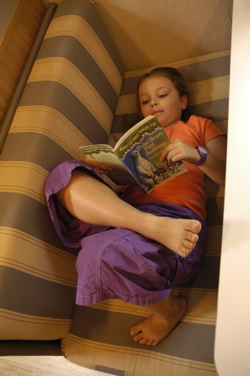
Eleanor took the opportunity to hunt up some groceries and when she returned I noticed how has been buying more dried foods lately. When we started traveling we had a large plastic bin filled with canned foods: soup, pie filling, tomato sauce, refried beans, condensed milk, pineapple slices, etc. You name it, it was in there — everything a good cook needs. The bin weighed about fifty pounds.
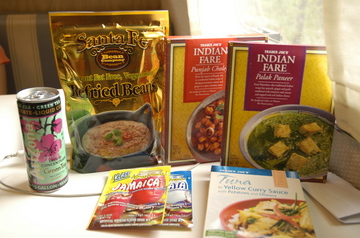
I was thinking that since she has discovered dehydrated and condensed versions of a lot of the things we like, that bin would get lighter. But it isn’t. Eleanor’s kitchen never shrinks. I can’t complain too much … I eat well.
We have renewed our site for another two days. We just can’t seem to leave Prescott, even though the weather is not nearly as nice as a few days ago. There’s a lot to explore. Tomorrow perhaps we’ll get that hike in the Dells. But in any case we will definitely leave on Thursday. Our site here is already reserved by someone else and there are many things we want to see on the way back to Tucson.
April 15, 2007 at 10:36 pm · Filed under FAQs
Our friend Doug recently asked if we were going to apply some of the energy and resource-saving principles of our RV’ing to our new house. That made me think. Despite the general perception of RV’ing as a gas-hogging self-indulgent hobby, I believe that RV’ing is actually very “green” — and the more nights you spend in an RV, the more you save.
This is because the fuel consumption of an RV is only a fraction of the overall resource picture. Yes, most RVs get 8-10 miles per gallon of fuel (sometimes more for diesel-powered vehicles). But when they stop moving, they are exemplary models of conservation.
I’ve touched on this before but never laid out the details. Thanks mostly to a water-saving toilet, a tiny 6-gallon water heater, and no dishwater, lawn or swimming pool, the daily water consumption of our household is always less than 10 gallons per person per day, even when accounting for our use of external laundry facilities. This compares to a typical household consumption of 150 gallons per day per person.
Our electrical usage is so light that we can power our entire home from a pair of 115 watt solar panels, in the summer. Our power budget on a typical sunny day is about 0.72 kwH. Compare that to 14-25 kwH per day used by an average household. When plugged into 30 amp power and occasionally using the A/C or heat pump, we use more, but still a fraction of an ordinary house because of the small space we heat and cool.
Same for propane. Our furnace, hot water, and stove a supplied by a pair of 7-gallon propane bottles. Our annual propane usage is a mere 100 gallons per year. Our last house had a 500-gallon buried tank and we topped it off several times each year. I could go on and on, but I think you get the point. Living small means less impact on energy and resources. We even produce less garbage because we buy less stuff.
Nearly any house we might choose would have a greater impact than the life we’ve led for the past 18 months. RV’ing is inexpensive largely because RV’ers choose to live small. So, for someone who has no other home to feed, I would argue that it is a very “green” option.
My point is not that everyone should sell their house and live in a trailer. Obviously that’s ridiculous. But our experience on the road has taught us valuable lessons about the clear economic benefits of consuming less and conserving more. I want to apply those lessons to our next home.
Today we took a small step in that direction. I’ve been reading articles about CFL (Compact fluorescent) technology. CFLs are way better than they used to be. Unlike the bulbs of a decade ago, they provide attractive light, with color temperatures very close to incandescent bulbs, without flickering. They are much cheaper to run, produce more light (lumens) than comparable incandescents, and they are getting so cheap that the economic benefits of switching to CFLs are indisputable. The only issue left is consumer perception: people still think “fluorescent” means the buzzy, flickering, greenish lights of years ago. That’s why manufacturers no longer call use the word “fluorescent” on the packaging.
So today I bought a four-pack of CFLs at Target. It cost $14 (on sale this week). Each bulb puts out more light than a 75-watt incandescent on just 20 watts, and lasts years longer to boot. These will replace four bulbs in the carport and entryway of the house. Once we’re inside, I expect to identify at least six other places we can replace the current power-hungry bulbs with CFLs. It’s a little thing, but I’ve learned the little things add up.
Our experience on the road has also reinforced simple practices, like using night air to cool the house and cut our air conditioning needs during the day. Or lowering the temperature on cold nights and using an extra blanket instead of the furnace. And yes, driving less to save fuel. (Believe it or not, we drove fewer miles in the past year on the road than when we had two cars and lived in a house.)
Now our challenge is to maintain the savings we’ve come to expect, when we come back to the house between trips. Instead of trying to live large, we’ll try to continue to live small. Every little saving is its own reward, and the challenge of finding those savings opportunities is fun, like a game. RV’ing taught us the joy of it, and it’s one more way that life “on the road” has changed us for the better.
March 25, 2007 at 7:19 pm · Filed under FAQs
As we consider the goal of having a home base, we’ve been tallying up the cost of this little luxury. This may be helpful — in reverse — for those of you considering full-timing in an RV, to see how much you’ll save if you sell your house while you’re out, like our friends Bobby & Danine.
Petey gave us an article that appeared in the Wall Street Journal, March 12, 2007, by David Crook, entitled, “Why your house isn’t the investment you think it is”. You may be able to find it online but I think you need a subscription to read it. The essence of the article was that houses are inefficient or even bad investments. Although people think they make money when they sell, in most cases they actually lose money when the cost of maintenance, taxes, insurance, and interest are factored in. Mr. Crook calls the check you get when you sell “a partial rebate” of what you spent, not a windfall or profit.
I looked at the numbers for our last house and found he’s right, at least in our case. It looked like we made money on our house, but we actually lost money. We actually would have been better off not building on the land we bought, renting for the eight years we lived in the area, and then selling the land — no kidding. For most people, it turns out, houses are something you buy because you want one, but from an investment standpoint you’d be better off putting money into rent and a mutual fund. It varies a lot from one local market to another, of course.
This naturally dampens our enthusiasm for having a “home base”. Financially, it’s pretty darned risky to plunge back into the real estate market when we don’t expect to be here for more than 7-9 months per year. It’s a huge luxury compared to the lightweight and inexpensive lifestyle of full-timing in the Airstream.
Our “housing” expenses, as full-timers, amount to $400-600 per month, plus an amortized $500 per month for the trailer itself. That includes our campgrounds, utilities (water, sewer, and propane), and maintenance. We don’t pay property taxes, or for garbage pickup, electricity (except this rare moment while we are staying for more than a month), cable TV, lawn mowing, Home Owners Association or condo association dues, etc.
This stuff is probably ho-hum to you, but we’ve been on the road so long that all of the expenses associated with owning a house seem outrageous to us now. Since we sold our house two years ago, we have become used to putting money in the bank account and having it stay here. I had forgotten how invisible forces seem to suck it all out when you have a house to feed.
So why buy? There are a few reasons still left:
1) We have a child. She is doing wonderfully in our homeschooling program and we love the time together, but we’d like her to have more friends and at least a test of traditional school for a year or two. We never intended to be full-time travelers forever.
2) Health care. Continuity of care is important when you have any sort of chronic illness. We’re pretty healthy right now, but there have been a few things to remind us that this can change. If one of us gets really sick, we’ll want to park somewhere and deal with it. Having a home base makes that easier, since we’ll already have known physicians and facilities to go to.
3) For people who are only going to full-time for a short period, hanging onto the house may be the smartest choice. The cost of selling (broker’s fees) and the cost of re-acquiring a house (closing costs, market appreciation) can be more than the cost of just keeping the old homestead.
4) Satisfaction of ownership. Sometimes, you just want to have a “nice” house and feel like it’s really yours. If owning a house is a big part of your self-image and makes you feel good, that’s a reason to have one that transcends financial matters. But I’d recommend that frequent travelers or full-timers be honest with themselves and acknowledging the house for what it is: a luxury, not a financial decision.
Renting is also a good option. In our case, renting an apartment or house would probably be cheaper than buying for the short term, so a big part of the buy/rent decision will be our willingness to commit to the area for several years, at least. Having an Airstream to let us travel (and spend summers in the cool northeast) makes that commitment easier.
This is a work in progress … we’ll let you know how it goes …
February 8, 2007 at 8:18 pm · Filed under FAQs
I promised I would write about the preparations for Mexico, so here’s an update. Joe and I have been going back and forth on the details as they turn up. The latest snag has been insurance — it’s expensive. US auto insurance is worthless in Mexico, and if you get in an accident, the Napoleonic code that Mexico uses considers you to be guilty until proven innocent.
What that means from a practical viewpoint is that a fender-bender is treated as a criminal offense, and so the parties involved will be “detained” in a prison cell until the authorities are assured that the responsible party can pay for the damages. So it becomes a matter of having good Mexican liability insurance, along with bail and legal services riders, to be sure you aren’t the person left rotting in a cell at the end of the day.
Fortunately, there are dozens of websites that quote Mexican auto/RV insurance online. We’ve been comparing coverages and shopping prices for days. For visits of less than 30 days it’s usually cheaper to buy a daily policy, and beyond that it’s cheaper to buy the 6-month policy. For combined truck and trailer value of $60k, on a 15-day visit (for example), I’m seeing premiums of $377 to $700 — quite an impact on the overall cost of a trip!
Of course, there are many variables that affect the price. Optional riders, medical payments levels, liability levels, and obscure details such as whether payouts are in pesos or dollars and where bodywork gets done. It’s much more expensive to get a policy that allows you to get repair work done in the USA rather than Mexico. And some companies have a good reputation for easy customer service over the phone in Mexico, whereas others …
So we’re proceeding with caution. I’m reading threads on RV.net forums, visiting various insurance websites, reading policies (and wow is that tedious!), and comparing the experiences of people who have gone before us.
To further complicate things, we need to figure out our exact dates of entry/exit if we are going to buy a daily policy. We can buy extra days while we are in Mexico, but it would be a nuisance. So the decision to buy a 15-day policy at, say, $403, versus a 6-month policy for $560, has to be considered carefully. It might be better to buy a 6-month policy for the flexibility in dates, and to retain the option to go back into Baja later this spring if we feel like it.
I’ve also made a checklist of things we need to do in advance of crossing the border: buy a telephone card, collect our documents (passport, vehicle registrations, and in my case a notarized letter from myself affirming I’m authorized to drive the company vehicles into Mexico), sanitize the water tank, buy a phrasebook, etc. Really, there’s not that much we need to do. I’m over-preparing this time because its our first trip.
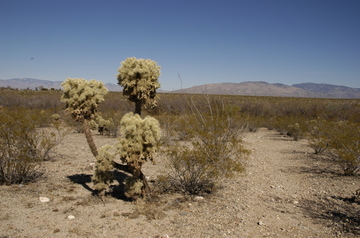
Today I took a short walk out into the desert for a lunch break. The area immediately around the campground isn’t particularly interesting except for the birds, but I could see taking a mountain bike out for some real exploration. I spotted some cardinals in the brush, and there seem to be a lot of songbirds in one area. The desert floor here is mostly brush with cholla (CHOY-ya) cactus, but it varies a lot depending on whether you’re on high ground or in a dry wash. The saguaro cactus (the ones with the “arms”) start a few miles north of here. We’ll see more of those when we go to Saguaro National Park.
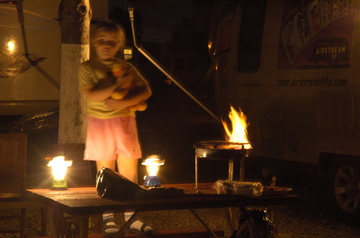
Cooking out under the bright desert stars
January 31, 2007 at 6:45 pm · Filed under FAQs
We’ve been flailing around with our itinerary lately, making changes every day because of whims or weather. I suppose that’s how it should be, so we can explore what interests us, but the time came to get serious about our plans for the next few weeks. So this morning we pulled out the maps, the weather reports, and our lists of obligations, and put together a plan.
The first decision was to move on rather than exploring Las Cruces. As a place to live it was never high on our list, and from my online searches there didn’t seem to be a lot to keep us here recreationally, either. Las Cruces is one of those places that is near a lot of stuff.
The second decision was to skip Silver City. This was a tough call, since I like that town and there are fun things to do in the area. But the weather has not been cooperative lately, and Silver City is up around 6,000 feet. We may return later.
The third decision was to attend the Tucson Gem Show. We were in Tucson for it last year and liked dropping in on all the various venues. This meant booking a moderately expensive stay at Beaudry’s RV Resort, because most places in town are full, but the location is very convenient. We’ll do a few days there for the show and then relocate a bit further out of town.
And the fourth decision was to face reality: we have a lot of on our personal and work schedules in February, and the only way we’re going to accomplish it all is to park ourselves for a solid month. So we’ll stay in Tucson through the first week of March.
But we won’t be sitting still. We have plans to explore two national parks, make an overnight trip up to Phoenix, visit Bisbee, fly to the Florida State Rally, check out local real estate, and make our plans to go to Mexico in March. Somehow all that will get done while I work on the Summer issue of the magazine.
We can’t get into Tucson until Feb 3, so we’ve got a few days to kill. With the weather cold, we decided to head to Rockhound State Park, in Deming NM. Our Google Earth location. This park is at 4500 ft elevation but that’s about as low as we can get in this part of New Mexico. There is snow just a couple thousand feet above us, but here it is at least above freezing, and there’s frequent sunshine.
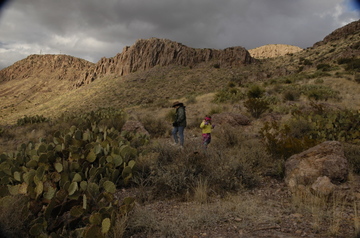
Collecting rocks in Rockhound State Park
Rockhound State Park was Emma’s choice. You can collect jasper, agate, opal, and quite a few other types of gemstones here. A short steep hike from the campground rewards you with beautiful views in all directions, and heaps of stone to pick through — no rock tools necessary!
We found a lot of jasper, plus some other pretty stones we haven’t yet identified. The rangers in the Visitor Center will probably help us with some, and we may call on our friend Mike Bertch, who is waiting for us in Tucson, to identify the rest. While we were up hiking around, I also found a cactus with my knee, which required me to gently roll up my pantleg (in 40 degrees and a cold wind) and carefully pluck about thirty tiny spines out.
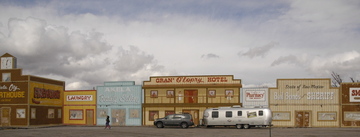
Near Deming, NM. Click for larger
Along the way here, Eleanor got a hankering for a tourist trap along I-10. Now she has a new leather hat, which you can see in the first picture. Emma has new moccasins too. I think that takes care of our tourist trap needs for a while …
January 21, 2007 at 11:04 pm · Filed under FAQs
Our hunt for a winter home has officially begun. Everything west of Austin TX to Borrego Springs CA is in our search area. So we spent the day touring and considering the merits of small towns in the Texas hill country, that area west of Austin and San Antonio where rolling hills and cedars and cattle make up the landscape. Amazingly I forgot my camera and so I have no photos for you today — sorry about that.
This evening, our friend and blog reader Jim Whitworth showed up at the trailer to take us out to dinner, which was a really nice surprise. Jim has offered a lot of useful advice about real estate in this area, and we’ll probably go to his house in a few days to learn more.
Rita, a blog reader from Portugal, recently wrote to us to ask some basic questions about the things we bring along for our full-time travel. Since we get asked this a lot, I thought I’d share Rita’s questions and our answers:
Rita: how do you know how many clothes to bring and how many pairs of shoes?…
We packed only what we need, which means not “something for every occasion.” We have clothes for dry and wet weather, cold weather as low as 30 degrees (with layering), and warm weather. We have enough clothes to last for at least two weeks in average weather, without doing laundry. We left about 3/4 of our clothing behind in storage and periodically return there to pick up new things and drop off clothes we are bored with.
Eleanor says you should pack your absolutely favorite clothes. That way you’ll enjoy what you’re wearing every day. She made the mistake of bringing “camping clothes” the first few months. When she realized the difference between camping and full-timing, she swapped all the clothes out for things she likes to wear and was much happier with her choices.
Each of us has three pairs of shoes, which is plenty for a wide variety of situations if you are thoughtful about what you bring. I have a pair of hiking boots, a pair of casual everyday shoes, and sandals. Since we don’t go to formal events, I was able to leave the wingtips at home. 😉 Emma has sandals, sneakers, and puddle boots. Eleanor has two pairs of sandals (one for hiking, one for dress), sneakers, and casual shoes. We all have a pair of slippers as well.
Rita: how about books and magazines?…do you buy them? after you read them do you keep them?…
Well, as a magazine publisher and avid reader, yes, I buy books and magazines all the time. But I don’t keep them. Books either get left at campground “book swaps”, mailed to friends, or shipped home for storage. All magazines get recycled with friends or thrown out — except of course AIRSTREAM LIFE! It’s a crime to throw out Airstream Life.
Rita: do you buy souvenirs?
Yes, but only very small ones. We each have things we collect. I collect stamps in our National Parks Passport. I also take digital photos — 12,000 at last count, of which I’ve retained about 5,000. These take no space and they are free, but very memorable. Emma collects small rocks (no larger than 1″ diameter) in a fishing tackle box. When the box gets full, some rocks get shipped back home. Eleanor collects National Park pins.
We do buy other things to decorate the trailer, but anything large gets shipped back to storage. That’s rare. We try to only buy things that are truly memorable and interesting — which doesn’t include t-shirts, coffee mugs, and other typical tourist stuff. For example, we bought a hand-made sotol walking stick in Big Bend National Park. This was very meaningful to us because it was made by a fellow we met from the Mexican town of Boquillas, who I interviewed and later featured in the magazine. We kept it in the trailer for a few months and then dropped it off in Vermont at our storage unit. Later it will be a treasured artifact in our next house.
Rita: how do you manage to keep the things on your airstream streamlined so that you are not overflowing in “stuff”, since we all know how “stuff” is so easy to accumulate? did the three of you make a rule on how to keep it light?
Yes, and the rule is simple: bring only what you need and for everything optional that comes in later, something else has to go. Even with this rule, we have managed to accumulate more stuff than we should have. So it’s important to periodically go through the entire trailer and look at everything with a critical eye: Do I need this? Have I used it in the past three months? Will I definitely use it in the next three months? If the answer is “no”, it goes away.
It’s amazing how much stuff we brought that we thought we “might need someday” and which has never been used. In fact, we are currently making another pass through our possessions, because the trailer is starting to get too close to our maximum weight for my comfort. So far we’ve filled two 14x14x14″ boxes with stuff to send home.
The bottom line is that you can’t bring it all with you. Nor should you. If you find you need something that you don’t have, you can usually get it readily enough. And a great lesson from this form of travel is learning what you really need — and that’s a lot less than you might think.
January 15, 2007 at 1:42 pm · Filed under Eleanor's posts, FAQs
We received this email from blog reader Larry Ko:
I love to cook Chinese, Cajun, Mexican, and Italian, making do with ingredients on hand. My kitchen is stocked with lots of infrequently used kitchen tools. What tools and appliances do you feel are a functional must for your AS kitchen? What basic items do you keep stocked in your pantry?
Hi Larry!
Good to hear from you. Lots of people ask the same questions you just asked, so I think this time I’ll “blog” the answers.
We don’t eat out a lot, but we are full-timers that travel around a lot. So, as we travel, I like to pick up local food items and cook with what I purchased. We always try to go to farmers markets and those little roadside stops that offer unusual local fare, like smoked fish, tangerines from 7th generation trees, garlic fried peanuts, or mutton tacos with a pickled serrano.
If you plan to camp some place remote, and want to have the “local fare” for your meals, pick up what you need along the way instead of packing it ahead of time. But, if you plan to be in the Northeast Kingdom of Vermont and think you may want Thai or Cajun, then make plenty of room and pack it with you. My philosophy is “I can always hand-wash t-shirts and undies but I can’t purchase gumbo filé in Organ Pipe Cactus National Monument.”
What basic items do you keep stocked in your pantry?
Fresh is best, so our refrigerator is always full. However, we gravitate toward out of the way places where diverse food items are not readily available. As a professional cook, there are certain things I refuse to do without. I love to cook many different cuisines, so I have way too much stuff in the “pantry”. Even though each thing is in small/single quantity, I still manage to fill four rubbermaid tubs, two overheads, and one cabinet. Rich complains that we have a trailer full of ingredients, but nothing to eat. 😉
My staple ingredients are:
rice: Basmati or Jasmine, Arborio (for risotto), wild, brown, and dried rice paper rounds (Vietnamese salad wrappers)
pasta: long, short, pearl, couscous
barley, lentils, flour (all-purpose & whole wheat), oatmeal, cornmeal, white grits, biscuit mix, baking powder & baking soda, white cake mix
raw honey, molasses, pure Vermont maple syrup and sugar: granulated, raw, dark brown, confectioners
tea: black, green, white, red, herbal (We don’t just drink it, I cook with it too.)
coffee: drip, perk, espresso
peanut butter, cashew or almond butter, white & black sesame seeds, unsweetened dry coconut
various dried fruits & assorted raw nuts (good for snacking & cooking), unsweetened chocolate, chocolate chips
oils: olive (reg. & Extra-virgin), soybean, macadamia, cooking spray
vinegar: balsamic (white & red), cider
salt: kosher, sea, iodized
pepper: whole black peppercorns, coarse & fine grind, white fine grind
canned/jarred: red & green chilies, diced tomatoes, tomato sauce, corn, black beans, mushrooms, coconut milk, coconut water, evaporated milk, olives, artichoke hearts, pineapple, pickles, salsa, garlic, ginger, basil, tamari, mirin, fish sauce, hoisin, nori, red & green curry paste
broth: chicken, beef, vegetable Progresso soups (for when I’m too tired to cook or we are very short on time)
wine: 2 dry reds & 1 white
dried herbs & spices: whole green cardamom, cumin, coriander, fennel, paprika, bay leaf, saffron threads, orange peel, lemon grass, sage, thyme, rosemary, cilantro, ancho chilies, chili powder, ground & stick cinnamon, nutmeg, cayenne, red pepper flakes, gumbo filé, curry powder, and my own mixes for dry rubs, bbq, & Indian masala
What tools and appliances do you feel are a functional must for your AS kitchen?
Now I need to be able to prepare and serve all those ingredients. As you know, storage space and weight are an issue, so I try to make sure that the things I have can serve more than one purpose. For example, the carafe of my 4-cup coffee maker is also used as a teapot, a pitcher, and a gravy boat.
I didn’t bring my “best” cookware — too heavy and too large. But I don’t like “non-stick” aluminum pans, so I purchased a standard 7 pc. set of mid-weight, durable, stainless steel pans (by Wearever) with the sandwiched-disk style bottom. To this, I added my favorite “risotto” pan, and an 8″ fry pan with sloped sides. Our friend Brad brings his favorite cast iron skillet for “blackened” cajun dishes he loves to prepare.
I also have:
-small roasting pan with a collapsable rack that multi-tasks as a cooling rack and trivet
-broiling pan (purchased as an extra from the oven manufacturer)
-4 qt. crock pot with removable “crock” – multi tasks as a “deep” casserole dish w/ lid, and a great way to slowly reheat or keep foods warm
-4 cup auto-drip coffee maker and a 6-cup stove top percolator (when there’s no electric and I still want coffee)
-2 cup stove top espresso pot (what can I say… I like coffee)
-hand blender (not mixer) and a 2-slice toaster
-3 pc. stainless steel mixing bowl set (multi-tasks as salad/serving/storage bowls)
-small metal colander and a small fine mesh strainer
-four culinary knives: 1 each – paring, 8″ serrated, 8″ chef’s, 6″ slicing
-small bamboo cutting board (doubles as a cheese board) and a medium one for use with my larger knives
-two serving spoons, 1 serving fork, metal tongs (multi tasks as salad/cooking/bbq tongs)
-two metal spatulas, 3 rubber spatulas and 3 wooden spoons of various sizes/shapes
-manual can opener, cork screw/bottle opener, citrus zester, instant read thermometer, pastry brush, small “box” grater, vegetable peeler, egg slicer, and kitchen scissors
-six metal skewers, a 2 oz. ladle, ice cream scoop, 1 cup measure and measuring spoon set
– metal serving platter, two metal pie plates, a bread basket and a fruit basket
– four oven mitts that double as hot plates
– disposable plastic containers of various sizes/shapes
– 4 bottle wall-mounted stainless steel wine rack (from IKEA)
– under-cabinet mounted paper towel holder
– wireless remote digital thermometer for the refrigerator (ambient temperature affects the refrigerator’s performance so I adjust the setting accordingly)
– “Corelle” dinnerware, four each: dinner, salad/sandwich, & dessert plates, soup & dessert bowls
– 4 stackable coffee mugs (from IKEA), a 5 pc. flatware set for four, and 4 steak knives (Man can only eat off paper and plastic for so long.)
We also have a small “disposable” (good for about 12 uses) charcoal grill that we store in the outer compartment, and a step stool so Emma can operate at a proper counter height and I can see what’s in the back of the overhead compartments. 😉
I didn’t start our trip with all this stuff aboard. It is a 15-month culmination of things I decided I wanted to have along in my kitchen for comfort as well as function. To help you determine what should be in you kitchen, I can suggest this technique: Put what you consider your kitchen necessities out onto your counter, review each piece and see if any can be used for more than one purpose. Those are the “keepers”.
Other items that are favorites or “must haves” are next, and so forth. You can cut a lot out with this type of process. Then find a place in your kitchen for everything you picked out – in order of importance. Make sure that the most frequently used or favored items are easy to access. Then cook a few meals in it. You will find that you missed some items, but also that you packed ones you didn’t use. Swap them out. I know there are things in my kitchen I could do without, but it would make cooking less fun, and I want to enjoy my kitchen — small as it may be.
« Previous entries ·
Next entries »







